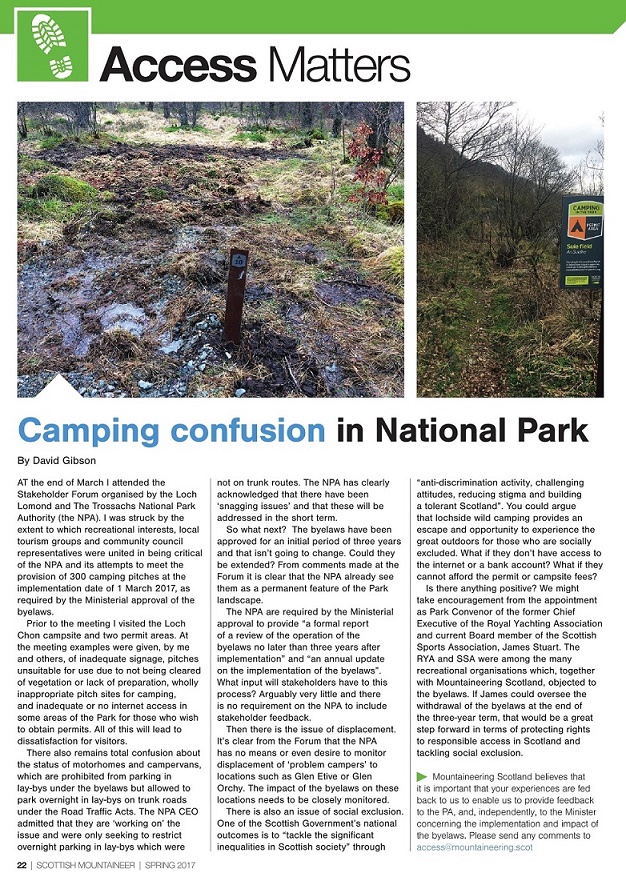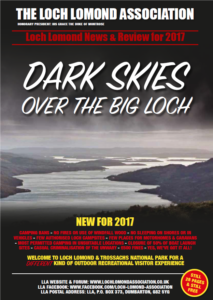
Reading and watching some of the excellent social media during the election campaign, like many I suspect, I found it hard to reconcile all that critical thinking – reminiscent of the independence campaign – with what the opinion polls were saying. I had concluded Thursday that the traditional media, mostly controlled by the rich and powerful whose interests require that “There is No Alternative”, had won the day and that even the BBC’s coverage of alternative views, which generally improves in election campaigns due to rules on election bias, had not resulted in a shift in public opinion. I was wrong. It gives me hope that parkswatchscotland and other social media could help change our National Parks as part of a much broader movement for change in all areas of life.
The LLTNPA’s attempt to control the way we think
Attempts to control of the way we think, extends to all areas of life, including National Parks. The relentless attempts of a significant proportion of national newspapers to denigrate migrants, the indy ref campaign or Jeremy Corbyn say, during the election campaign are, in my view, little different from the Loch Lomond and National Park Authority’s attempts to denigrate campers. The LLTNPA uses many of the techniques used by the Sun and Daily Mail:
- telling photos (dozens of photos of abandoned tents, though many of these are the same abandoned site from different angles)
- ignoring data (the LLTNPA did not use its own data collected by Rangers on numbers of campers)
- falsifying statistics (the LLTNPA fiddled the result of the Your Park consultation by re-classifying some supporters of extra campsites as supporters of byelaws)
- quotes from alleged victims to create support (human faeces found on a doorstep was blamed on campers)
- smearing/discrediting opponents (Gordon Watson, now the Park’s Chief Executive, tried to discredit former Chief Inspector of the Police, Kevin Findlater, when he questioned the need for byelaws based on his experience of addressing the problems on east Loch Lomond by bringing up quotes from the past).
In terms justification for their actions, there is even a parallel between Teresa May’s endless repetition of “strong and stable” and Gordon Watson, who for the last six months, has been incanting “there are too many campers…………………”.
The LLTNPA, like many other establishment organisations, employs a disproportionately large media machine to carry out all this work. Out of 135 staff employed in March 2016 eight are in “communications” while it also pays the Big Partnership to liaise with the traditional media. The job of these people is to feed biased information into the traditional media, which then tend to regurgitate it uncritically (a situation not helped in newspapers by cuts in staff numbers) and promote the Park’s propaganda on social media. For a time this was very successful. During the consultation on the camping byelaws most of media printed uncritically shock horror images of campers circulated by the National Park with no critical comment. While there were a few honourable exceptions to this, most of the critical coverage was in form of one-off articles, and it was left to the letters page of the Herald to provide a forum to promote alternative views. It was as a consequence my experience of having failed to get sustained critical coverage of the LLTNPA in the traditional media (not just camping, but secrecy, the follow up to the Owen McKee scandal) that I was prompted to set up parkswatchscotland and broaden its scope to cover the Cairngorms.
 One reason for the lack of critical media coverage, which I did not appreciate at the time, was that whenever critical coverage of the byelaws appears, the LLTNPA media squad complains about biased coverage. I have heard on good authority that following Patrick Barkham’s excellent piece (see here) the LLTNPA made a complaint to the Guardian. A recent example of this (see left) is the LLTNPA getting a right of reply to David Lintern’s article in The Great Outdoors. The LLTNPA also appear to be trying to shut down critical coverage in social media. For a few short time a new facebook page appeared (https://www.facebook.com/lochlomondnationalpark) with satirical photomontages of destroyers in Park livery patrolling Loch Lomond looking for campers. The page has now gone and the only reason I can think of is the threat of legal action from the LLTNPA, either against FB or the person who put it up.
One reason for the lack of critical media coverage, which I did not appreciate at the time, was that whenever critical coverage of the byelaws appears, the LLTNPA media squad complains about biased coverage. I have heard on good authority that following Patrick Barkham’s excellent piece (see here) the LLTNPA made a complaint to the Guardian. A recent example of this (see left) is the LLTNPA getting a right of reply to David Lintern’s article in The Great Outdoors. The LLTNPA also appear to be trying to shut down critical coverage in social media. For a few short time a new facebook page appeared (https://www.facebook.com/lochlomondnationalpark) with satirical photomontages of destroyers in Park livery patrolling Loch Lomond looking for campers. The page has now gone and the only reason I can think of is the threat of legal action from the LLTNPA, either against FB or the person who put it up.
A specific reason for the lack of critical media coverage on camping is that the LLTNPA raised such a fury of righteous indignation about abandoned tents that almost no-one dared question the basis or rationality of their proposals. So you want camping to continue, despite all those wrecked tents or turd on the doorstep – what sort of person are you? (The parallel being that if you voted against restriction of civil liberties as a means of “fighting” terrorism, you must be like a terrorist). This was most effective in silencing the recreational organisations who did not want to be seen to defend irresponsible campers.
The CNPA
The Cairngorms National Park Authority, while still far from fulfilling its original purpose, is far less guilty of spin and speak than the LLTNPA. While not beyond criticism in that regard – for example it has tried to stop Board Members from speaking out and recently stopped recording its planning meetings – but has generally has been far more open in the way it operates than the Loch Lomond and Trossachs National Park and far less guilty of Parkspin. Its also helped that one local paper, the Strathy, has been prepared to encourage debate about what the National Park does in a way rarely seen within the Loch Lomond and Trossachs National Park.
The development of a critical media
 There are welcome signs now, however, that things are changing and both the recreational organisations and recreational media are speaking out. While Mountaineering Scotland has given good coverage to its concerns about the byelaws, its significant that in May its Chief Executive, David Gibson wrote what I think is a damning criticism (see above), while the LLA magazine (left), is even more outspoken and has treated the Park’s attempt to justify their cleansing of people from the Park with derision.
There are welcome signs now, however, that things are changing and both the recreational organisations and recreational media are speaking out. While Mountaineering Scotland has given good coverage to its concerns about the byelaws, its significant that in May its Chief Executive, David Gibson wrote what I think is a damning criticism (see above), while the LLA magazine (left), is even more outspoken and has treated the Park’s attempt to justify their cleansing of people from the Park with derision.
On the social media side, David Lintern, the brave outdoor journalist, who deliberately broke the byelaws, had an article published on UK Hillwalking on Wednesday (see here) which has been read over 7000 times. Compare this to the latest propaganda video from the LLTNPA on its Facebook Page (see here), which justifies permits on the grounds that you have the “comfort of knowing you have booked your pitch” – what on a stony lochshore? (see here) – which has been viewed just 3,500 times and has received a number of critical comments. In fact anything now posted by the LLTNPA on social media now tends to attract critical responses.
There is still a long way to go. The LLTNPA FB page has over 14500 likes, compared to Parkswatchscotland’s FB Page’s 230 likes – a massive difference – but I take comfort that parkswatchscotland received over 40,000 hits the day Nick Halls’ article, also titled “Camping confusion in the Park” appeared. Again this dwarfs the number of people who watched the Park’s camping propaganda video.
| Day | Number of visits | Pages | Hits | Bandwidth |
| 01 Jun 2017 | 866 | 3,114 | 21,070 | 2.67 GB |
| 02 Jun 2017 | 634 | 2,675 | 14,430 | 1.24 GB |
| 03 Jun 2017 | 969 | 2,621 | 20,410 | 1.44 GB |
| 04 Jun 2017 | 552 | 2,610 | 11,708 | 1.14 GB |
| 05 Jun 2017 | 3,225 | 7,211 | 40,757 | 3.42 GB |
| 06 Jun 2017 | 992 | 3,818 | 17,324 | 1.79 GB |
| 07 Jun 2017 | 536 | 4,025 | 18,613 | 2.33 GB |
| 08 Jun 2017 | 769 | 3,082 | 16,686 | 1.81 GB |
| 09 Jun 2017 | 399 | 2,692 | 11,221 | 1.95 G |
The two days with over 20,000 hits saw publication of posts on the artificial ski slope at Cairngorm and the Strangled Hare.
I suspect a good 2-3 minute video exposing either the LLTNPA’s approach to camping or Flamingo Land or what the CNPA is allowing to happen at Cairngorm could attract 100,000 views or more – anyone up for this?
Where next?
Far more people now appear now engaged with the critical opposition to what is going on in our National Parks. Parkswatch is pleased to have played a role in that but I would hope now that on various issues, from the involvement of big business in trashing our landscape to access rights, we can take that critical opposition to another level and change our National Parks so they start fulfilling their original purpose.
The challenge of changing our National Parks, is part of the challenge of how we change society, and both need an informed, concerned and active public.

Keep up the good work. I ll share this on Facebook as usual.
To be successful on social media you need to keep the message short succinct and snappy. As someone who’s passionately interest I read your stuff in full but I think a brief opening synopsis might have more impact on more casual readers. Kind regards
Ian
Yes, several people have said the same and a mate of mine says parkswatch is too serious. I think there is place for both, parkswatch is trying to develop serious analysis of what is going on but we need other people – far more talented than me – to convert that into the short and snappy!
Sorry Ian, should have also said, summary at beginning good idea!
Parkswatch cannot be “too” serious. The level of analysis is refreshing. By all means condense or simplify for other outlets but don’t tamper with Parkswatch! Apologies for having no social media skills to help, though I do tell people about the site.